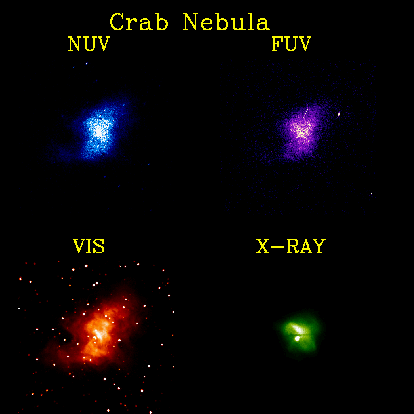Astronomy Picture of the Day
Discover the cosmos!
Each day a different image or photograph of our fascinating universe is
featured, along with a brief explanation written by a professional
astronomer.
September 9, 1996

The High Energy Crab Nebula
Credit:
NASA,
UIT
Explanation:
This is the mess that is left when a star explodes. The
Crab Nebula
is so energetic that it glows in
every kind of light known.
Shown above are images of the
Crab Nebula from visible light to the
X-ray band.
NUV stands for "near
ultraviolet" light, FUV means "far
ultraviolet" light, and VIS means visible light. In the center of the
Crab Nebula lies the powerful
Crab pulsar - a spinning
neutron star
with mass comparable to our
Sun but with the diameter of only a
small town.
The pulsar expels particles and radiation in a beam that sweeps past the
Earth 30 times a second. The
supernova that created the
Crab Nebula was seen by
ancient
Chinese astronomers and possibly even the
Anasazi Indians
-- in 1054 AD, perhaps glowing for a week as bright as the
full moon. The Crab
still presents mysteries today as the total mass of the nebula and pulsar appears much less than the mass of the original pre-supernova star!
Tomorrow's picture: M77: Spiral with a Strange Glow
| Archive
| Index
| Search
| Glossary
| Education
| About APOD |
Authors & editors:
Robert Nemiroff
(MTU) &
Jerry
Bonnell (USRA).
NASA Technical Rep.:
Sherri
Calvo.
Specific rights apply.
A service of:
LHEA
at
NASA/
GSFC
